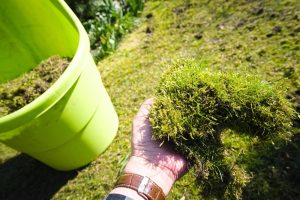While they may look great when spread over expansive wooded glades, mosses are not good for your lawn. In addition to making your lawn mushy and uneven, moss also competes for water and nutrients with your grass leading to an unhealthy lawn.
Mosses – which are known to thrive in shaded areas with poor drainage – can slowly take over a lawn that’s in poor health. Have you spotted moss on your lawn? If so, read on below to find out some useful landscaping tips on how to remove moss from your lawn.
What Is Lawn Moss Control?
Lawn moss control refers to the strategies used to remove moss from lawns. Some of the most popular and effective moss control products include those based on iron and iron-containing substances such as ferrous sulphates. This is mainly due to the fact that moss does not do well in soils with a lot of iron.
For utmost effectiveness in dealing with this persistent lawn intruder, moss control strategies also include ways of resolving the underlying problem that is causing the moss to grow in the first place.
Techniques To Control And Get Rid Of Lawn Moss
- A Dose of Iron: As previously mentioned, moss does not do well in soil rich in iron. With that in mind, you can prevent moss growth with a good dose of iron. Most of the moss weed killers available out there include iron sulphate, as an ingredient. Spraying one of the highly-rated moss killers all over your lawn is definitely going to help you get rid of this unwanted lawn guest!
- Washing Soap: Want to use a simple home remedy to counter moss growth? If so, you are in luck! You can make a simple but effective moss killing solution by mixing about 100ml of dish soap with about ten litres of water (or less depending on the size of the area with the moss). Pour the solution into a garden sprayer and then spray the affected area, generously – without drowning it.
- Lime: You can also add a lime solution to your garden sprayer and use it as a moss killer. This is a great solution for acidic soils as it changes the soil ph by reducing acidity, thereby making it more conducive to healthy grass growth. Once you have used the above techniques to kill any moss growing on your lawn, you can then use a rake to remove it after it turns brownish.

Moss Removal Action Plan
- Using High Iron Fertiliser as a Substitute for Iron Sulphate: If you intend to kill moss before raking, you can use a high iron fertiliser in place of a soluble ferrous sulphate weed killer. The fertiliser is highly effective at this stage because it acts slower, for longer.
- Moss Killer Penetration: If you choose to use ferrous sulphate before raking, be sure to apply it anywhere between seven and fourteen days prior. To enhance penetration, make sure that your lawn is damp during the application (avoid this when using a moss killer designed for use in dry conditions). You can also enhance penetration by giving your lawn a light high topping with the mower.
- Soil pH: To avoid creating soil ph variations that will affect the health of your lawn, it is recommended that you use moss products evenly across the lawn – as these products lower the pH level of the soil, making it more acidic.
- Raking: Dead moss should be raked away on a dry day when the grass is actively growing. To expose the moss and reduce resistance on the rake, be sure to trim the grass beforehand.
- Applying Ferrous Sulphate Before and After Raking: Remember to leave about 4 weeks in between ferrous sulphate applications, if you decide to apply it before and after raking. Making two applications of this moss killer too close together may end up damaging your grass.
- Over Seeding and Fertilising: You can complete the moss killing process by immediately overseeding and fertilising your lawn if you don’t intend to apply a second dose of ferrous sulphate after raking.
- Killing Weeds: Where young grass is concerned, you should only apply lawn weed killer around 2 months before or after germination/seeding.
Final Thoughts
In addition to having a good grasp of the above lawn moss control and removal techniques, you should know when to remove moss from your lawn. The best time to remove moss from your lawn is during spring and summer when your lawn has ample time to recover.
Landscaping Rock Supply & Installation
To find out more about lawn moss control techniques from seasoned experts or to book a professional lawn control service, contact Rokworx. At Rokworx, we can help you with everything from landscaping rock supply and installation to moss control.
Please call us today for more information on 0407 456 045 or leave us a message.



